![]()
The Words Of The Schneider Family
|
|
The Words Of The Schneider Family |
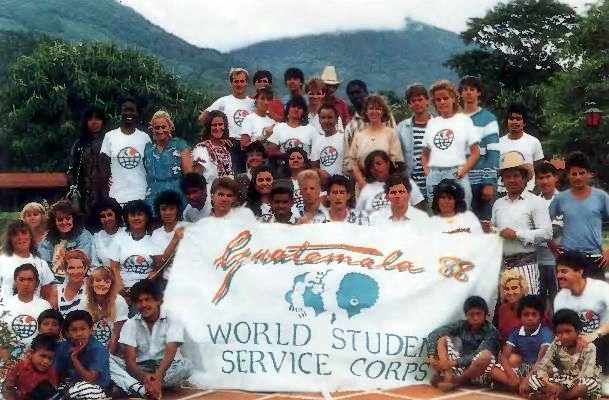
The
WSSC participants in Guatemala, along with some of the local
children, at the close of their summer project.
Only a few short months ago, Guatemala conjured up images in my mind of sweltering jungles of exotic tropical foliage, sunburned workers tending bananas and coffee, an occasional earthquake, and not much else. Upon my arrival there this summer, I found so much more. Guatemala is a country of extraordinary beauty and variety in the land and especially in the people. Working there on our service project was undoubtedly one of the best experiences of my life.
I was not alone in these perceptions. With me this July were about 35 participants of the second annual World Student Service Corps project. Initiated in 1986 by World CARP President Hyo Jin Nim at the Third CARP Convention of World Students in New York City, the WSSC has developed into a kind of student "peace corps," conducting projects on both local and international levels. This year, representatives from more than 12 different countries arrived at their own expense in order to participate in a month of service. There were 16 American students from 8 major campuses across the USA, as well as participants representing Argentina, Australia, Canada, Columbia, the Dominican Republic, El Salvador, Guyana, Honduras, Mexico, Singapore, and West Germany. Several students and staff from Guatemala also attended. It was obviously a very rich and novel experience of cultural exchange for the students and for most of them, their first.
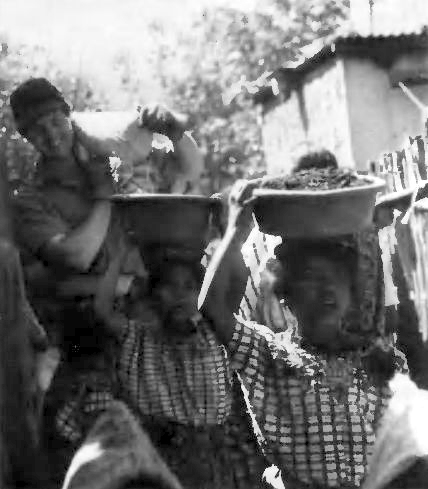
Gary
Page, project director, with the plucky schoolchildren who helped
carry the supplies on their heads.
Working on final preparations as project director, I arrived in Guatemala three weeks early. Invaluable assistance was offered by our two missionaries in Guatemala, Fritz and Anna Schneider, and their home church contacts. We organized four separate work projects in two different villages in the beautiful Lake Atitlan region. Ambitious plans were made to complete two community centers begun last year, build a new school, and repaint another. It was our pleasant circumstance that the locality in particular need of service happened to be an area often reputed to be the most scenic in Central America.
I found Guatemala to be a country of many contrasts. From steamy lowland jungles to the vast temperate highland regions, which comprise the major portion of the country, almost anything will grow in Guatemala -- all of the time. The country is known as the "Land of Eternal Spring." There are flowers always in bloom and fruits always in season. But it is also a volatile land of many earthquakes and volcanos in constant eruption. While I was there I had the "good fortune" to experience both!
Over a mile high, Lake Atitlan is truly a gem of natural beauty. Volcanos and lush vegetation surround its waters, and the way of life of the Indians who live along its shores is rich in tradition. Guatemalan Indians, a strong majority of the country's population, are a warmhearted, close-knit, family- oriented people. They still wear their exquisite hand-woven clothing for everyday use and cling to many of the traditions of the ancient Mayan civilization from which they are descended. Life goes on in the villages as it has for many hundreds of years.
Life is hard for them. Yet they go about uncomplainingly, toiling from dawn until dusk, eking out a subsistence living by working their small plots of land on the mountainside and occasionally selling their woven wares at the market. Because they own no modern machinery, their livelihood rests on the strength of their backs. And it eventually takes its toll. The average life span in Guatemala is barely 60 years, and the literacy rate is under 50 percent. To work among these people is to experience a constant collage of colors and smiles, yet one is always aware of the bare destitution of their lives. Guatemala's rich cultural heritage amidst a splendid scenic backdrop, coupled with the very evident social and physical needs of its people, inspired many young students to come this summer and participate in our service work.
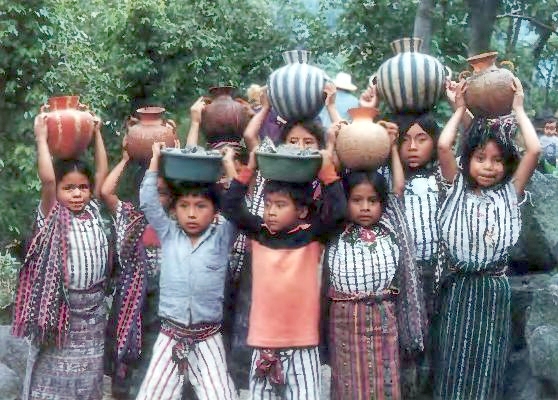
The
children of Santiago in their brightly-colored, hand-woven clothes.
And so, on June 30, they came to Guatemala City, a bustling metropolis quite unlike the rest of the country. The participants stayed in a modern hotel for three days and were provided with a tour of the city as well as the opportunity to explore on their own. They heard presentations on the WSSC vision of student service and received important background information on the culture, history, and circumstances of the Guatemalan people. A notable contribution to the schedule of events was an interesting cultural talk and musical presentation from Congressman Baudillo Ordonez, the representative from the province in which we would be working and also a foremost marimba player.
After the orientation, we left the city for the countryside, traveling by bus for three hours along the Pan American Highway to the Lake Atitlan region, the area of our worksites. There we were greeted by breathtaking views of the lake and a waterfall cascading down from the surrounding mountains. Everywhere along the road we saw villagers dressed in colorful native garb on their way to the markets with baskets balanced on their heads and babies on their backs. It was like entering another world.
Arriving at the lake, we took a one-hour boat ride across to the village of San Pedro, located directly beneath a dormant volcano of the same name. This village is one of 12 villages surrounding the lake, each named after one of the 12 apostles. It was here on the shore of the lake that our "hotel" was located, our home for the next month. Living circumstances were quite humble -- bare but clean rooms, cold showers, and simple local Guatemalan food. Yet we noticed that many villagers were far less well off.
Each morning we rose early and had a breakfast of beans and tortillas, porridge, fried plantains, and sometimes eggs, which we ate in the hotel restaurant, a pleasant outdoor grass-roofed pavilion that overlooked the lake. Then we commuted every day by boat to the worksites in the villages of Santiago and San Marcos.
Incidentally, we found boat travel to be the only practical means of transportation in this region. The dirt roads between the villages around the lake resembled dried creek beds. An adventurous motorist would often have to get out and move boulders and branches in order to clear his way through. A few times it was necessary for me to make this excursion so that I could reach a telephone, since there were no telephones on our side of the lake. The eight-mile trip took almost an hour.
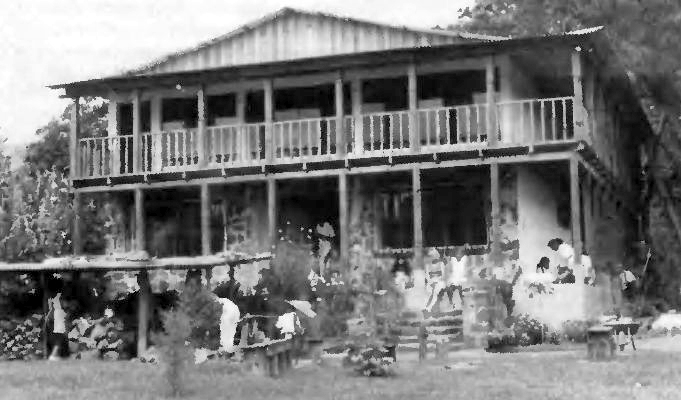
The
completed community center built by the WSSC volunteers.
Another interesting aspect of rural Guatemala -- and almost anything outside of the capital is "rural" -- is that each village has its own distinct forms of dress and village traditions. A myriad of different dialects is spoken. These have evolved out of native languages passed down from the great Mayan civilization that mysteriously disappeared shortly before the Spanish conquest over 400 years ago. Spanish is learned and spoken only as a second language, if learned at all. Many Mayan religious and ceremonial practices still survive today. Guatemala is a virtual mosaic of various small subcultures within itself and is one of the few Latin American countries to so effectively retain its indigenous cultural heritage.
Each WSSC team worked hard to complete its assigned projects within the three weeks of working days. In the larger village of Santiago, the volunteers finished two construction projects and one large painting project. A sizable two-story community center begun by last year's WSSC participants was completed beautifully. This multi-purpose building is to serve as a base for upcoming community service programs, including seminars on medical and agricultural education, various adult education classes, school board meetings, and other functions according to the specified needs of the community.
Also in Santiago, the students built a modern two-room public school to replace an older, severely inadequate structure. The previous school was an adobe mud-andbamboo shack without windows and with only a few supplies for the children's needs, all of which made for very appalling teaching conditions. The new school building, which could accommodate 70 elementary grade students, served to advance the goal of the local Board of Education: to construct a new school building in each district. In addition, the WSSC provided an ample supply of badly needed school provisions.
This project was especially rewarding for the student volunteers. Trained by skilled laborers working in conjunction with the students, the volunteers participated in the school's construction every step of the way. They leveled out the foundation, constructed the steel infrastructure, mixed and poured the cement, and laid the bricks. The building process required not only a good deal of heavy labor, but also a healthy dose of cultural integration, as the construction was directed in three languages -- Spanish, English, and the local indigenous dialect, Tzutehil. Extra assistance came from the children themselves, who participated in carrying the building materials from the trucks to the worksite -- no small feat in itself. The worksite was located at least 100 yards from the nearest possible drop-off spot.
We and the children together literally carried the school in on our backs! The exhausting efforts of the children were particularly moving to us all.
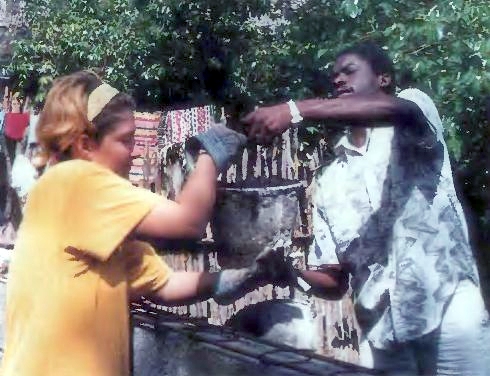
The
volunteers participated in every step of the construction work.
For the third project, the Santiago participants repainted, both inside and out, a large 20-classroom, two-story public school located in the center of town. Assisted by local students, parents, and teachers, this project brought the community together in many ways and on many levels.
The fourth project was conducted in the smaller village of San Marcos. Working upon the foundation begun last year, the students completed a multi-purpose building to be used as a weaving cooperative for the village widows. It will serve various other functions as well, such as a location for municipal and school board meetings and as an adult education center.
Besides the overall satisfaction of doing valuable service for others, we each had many memorable and special experiences in our interaction with the local people. I will never forget the delighted faces of the schoolchildren upon receiving their new pencils and balloons, or the generous family next door to the school construction site who offered to store literally tons of building materials around and even inside their house. I'll never forget the hotel owners who became our good friends and who surprised us one night with a farewell party and banquet. And of course I will always remember how the community leaders and people of the villages, out of gratitude, made several home-cooked dinners for our group and hosted official village ceremonies in honor of our efforts. Expressions of heart were apparent everywhere.
Throughout our time there, evenings in San Pedro offered us opportunities to experience many cultural events. Often we found ourselves challenged by local sports teams to basketball and volleyball games. (They usually won.) Some of the students organized evening weaving classes with a native teacher at her home, where she taught them, using sign language, how to hand-weave the colorful and traditional fabrics of the area. There were always many spontaneous gatherings. We played games, made music, sometimes danced, or just enjoyed the simple sharing of our experiences.
On the weekends, the students were provided with trips to historic cities and cultural sites around Guatemala, offering an overall perspective of the lifestyles and landscapes of the country.
The last few days were spent in Guatemala City with an emphasis on evaluation and reflection and the planning of future WSSC projects.
To climax the whole program, we were fortunate to meet with Dr. Joon Ho Seuk, national director of USA CARP and president of the WSSC, who flew into Guatemala City. There he was received by Guatemala's president, Venicio Cerezo, in a meeting that also included all of the WSSC participants. President Cerezo expressed his appreciation of our work and extended his welcome to us to come back to Guatemala as often as we'd like.
At the closing banquet, after several inspiring speeches and testimonies, certificates of participation were awarded.
As the 1988 WSSC international project drew to a close, I was able to clearly see that just a short time in service abroad had left a deep resounding impact upon each one of us. The experience of people of very different cultural, racial, and linguistic backgrounds coming together, not just for dialogue but for a common purpose under real- life circumstances, had immeasurable value in forging substantial bonds of heart. It was apparent to every one of us that the common base that made this all possible was service. We were impressed by how much we could do for others in such a short amount of time. For the students, an important realization was that service to others creates a natural "high." And all of this means that the summer WSSC project indeed accomplished its purpose.
Over the last two years in which WSSC projects have been conducted in Guatemala, news of the service corps has spread throughout the neighboring villages in the Lake Atitlan area. We have already received solicitations for next year from five different villages, including requests to build new schools, a community center, a health clinic, a regional emergency center, a washing facility, and a children's playground. Fortunately the spirit of volunteerism is rising on the campuses. We are seeing that there is indeed still very much for student volunteers to do in Guatemala and in many other places in the world.
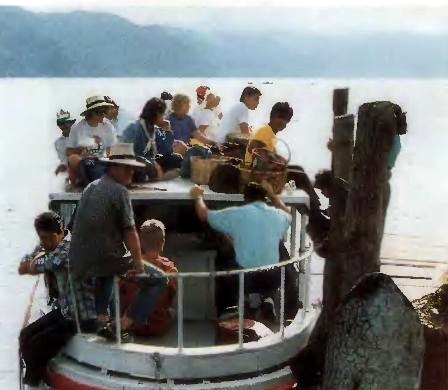
Boat
travel was the only practical means of transportation in the region.
Being the missionaries to Guatemala since the end of 1986, my wife and I were involved in both the preparation and the running of the World Student Service Corps project here. Our personal experiences were deep and the benefits for our mission valuable.
To be a member in a country where the mission has not taken off to great heights bears certain spiritual challenges! You hear of Father's vision of internationalism and one world under God. You read of international conferences and big gatherings and see pictures of accomplishments like The Washington Times. Those of us who had the opportunity to be involved with some of those victories easily forget how essential is the experience of participating in something beyond our own immediate frame. It widens our horizon and creates the substantial feeling of being a part of the world providence. In this respect, our members here identified themselves eagerly with the World Student Service Corps project and its responsibilities, even before it began.
It was not a problem to find volunteers to help organize the difficult tasks of cooking and the purchase and transport of building materials. Using their personal connections, they always managed to get the best deals. In matters of cultural differences, they handled problems and arranged situations in a sensitive way. How could we have otherwise improved, for example, the standard of hygiene and the menu in the small, rather primitive hotel, which was to serve as our home for three weeks, without offending anybody? On the foundation of their commitment, our members naturally felt connected with the brothers and sisters from the other countries as soon as they arrived to work on the project.
As hosts, we longed to make everybody familiar with the country itself, her people, and her customs. Yes, we mentioned the beautiful weather all year round. We showed them the volcanos and the colorful traditional costumes, and we warned them of the food offered in the streets, of the dairy products, and the water.
The list was long, and yet most of the special aspects of the country the students naturally discovered by themselves in their daily circumstances. They had their "packed-like-sardines" experience riding in the public buses, felt horrified by the wild traffic, and challenged themselves to try bargaining at the central market, which seemed just as wild. It didn't take them long before they could even use "Tse, Tse!" to call the waiter in a restaurant and the "Muchas gracias!" and "Buen provecho!" formality after finishing a meal.
Hearing their emotionally charged "Wow!" in seeing Lake Atitlan and, in contrast, observing their depressed silence in meeting the poverty in the villages made me reflect upon how insensitive and indifferent I had become to the beauty of my surroundings and how dull my heart had become in response to the pain of the underprivileged! I guess the beauty I had seen so often, and against the poverty I had erected a shield with the excuse that the problem of beggars and slums can't be solved at this moment, neither with charity nor with pity. I determined to deepen my appreciation for nature and keep it alive by sharing it with others. To revive that compassionate heart, I resolved to keep the faces of the crippled and of those begging children in my mind with the promise that, whatever I do here, it is to serve them.
It seemed to me that many of the participants, if not all, had that same attitude of heart while working at the construction sites. The need for service was glaringly apparent. Even without it being pronounced in words, every conscientious person among us understood in the course of the program the purpose of the World Student Service Corps -- to unify the world's students around the ideal of service and to foster a sense of caring. We learned to value each other within the group and those from the community, especially, of course, those we shared our activities with. It was not always easy to bridge the barrier of language. Communication had to occur on the level of heart with the desire for unity. Without that element, the hand and feet gestures would have led to impatience and destructive confusion, as happened in the story of the Tower of Babel.
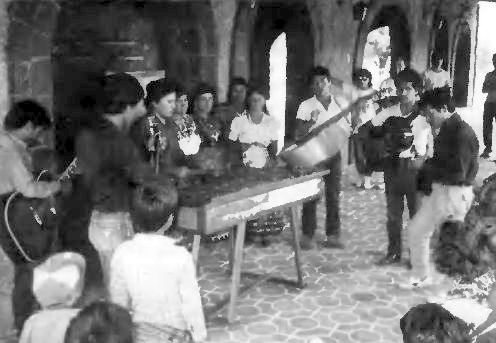
A
marimba band performs at a festival held in honor of the WSSC.
People became friends, and everyone carried home with them unforgettable memories. It was an experience of hope that the vision of one world where people serve people is not an illusion, that everyone has unique value and can contribute something and learn something.
The many testimonies given in the course of the project and at the final banquet were profoundly moving. The quality of changes individuals went through during their month here was evident from their testimonies. One of the students shared that before he arrived in Guatemala he didn't really know what to expect from this project. He knew for stare that it wouldn't change the world overnight. He wondered, would it be like throwing a small stone into the ocean, only to see it sooner or later washed back to shore? In other words, would it be only a token project without lasting influence? He worked at the school and watched the schoolchildren move a pile of dirt like ants -- some in buckets on their heads, others in sacks on their trip back -- from a place over 100 meters distant from the construction site. He saw their parents filling the buckets and the teachers mixing the cement. He invested a lot also and realized that the donation of materials, and his and the others' presence there, actually mobilized those people to help themselves. He went back to the States with some typical Guatemalan product, which he will use to raise funds for future projects.
Another sister expressed emotionally, "It just felt good to serve -- and it still does!" One of the quiet ones gave her raincoat to our local foreman, who had patiently introduced us to the skills of building. It rained a few times, so she felt he might need it more than she did. How much the attitude of our two foremen had touched the hearts of the students I sensed on the last day when I saw one of our brothers give them a present, which he had obviously bought with virtually his last money.
The respect the group received from the local people in return was voiced by one of the teachers we worked with: You are the first ones who did what you promised. You have set an example for us with your attitude." And the two foremen, Don Luis and Don Jose, still ask me about William, Nils, and all the others.
It is the inner personal gain of each person involved that gives even more importance to the WSSC project than the external accomplishments of painting a school, building another, and finishing two community centers. I feel that the influence of these projects will indeed multiply and eventually shape a new generation. Even the more skeptical, critical people will look into the philosophy behind it and will see and value the greatness of Father and his work.
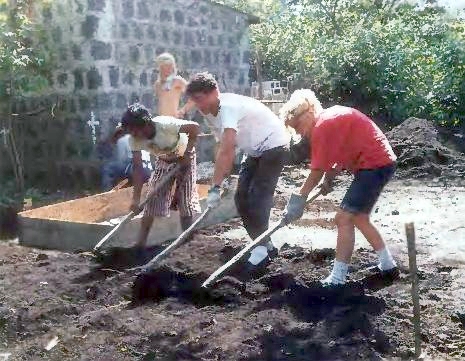
Leveling
the foundation for the school.
I am a person who usually gets excited, but this time I felt over-excited to get to the project site! At first I couldn't understand why I was so excited -- then Martha said to me: "Service is a high!"
I agree with the old saying that it is better to give than to receive. I've never seen any children work as hard as these [Guatemalan] children did, which is another thing that kept me going. I think everyone was touched deeply by this experience. It is one that I will be able to share and keep with me forever.
I want to thank the WSSC, because without this project I may never have had the opportunity to know this special feeling that comes from serving people.
D. Mast
Ohio State University,
Columbus
The most valuable thing that I learned was that the work we did with the [Guatemalan] people brought us close together. My first impression of Santiago was not very good, but working together with the people in the village changed that. From that experience I could see how "tourists" usually miss having a real experience of the country itself when they visit abroad.
What was really impressive to me was the willingness of the little children and village people to work hard with us.
I always thought that I was the only person who wanted to help in a third world country. When I was there working with other students from all over who had the same feelings as I did, I felt comfortable. In fact, I feel like I've met some of the best students in the world.
T. Miller
Ohio State University,
Columbus
I would like to thank everyone behind the scenes who made this all possible. For me, it gave me the purest kind of gratification.
Every day we walked by the old school we were replacing, which was just a small shack made out of bamboo, carrying supplies to the new worksite. The students were helping us build their own school! We watched this two- room building grow in front of our eyes.
It is going to withstand the next earthquake, and especially keep those kids dry during their studies. I've been in school for the past 14 years, and building this school for me was probably the most gratifying project I have ever been involved in.
One participant described the USA as being an over-developed country in a sense. Externally over-developed, but mentally and internally underdeveloped. If I look at how much patience I have towards things like work, I have noticed that I don't really give any more than 10 minutes of my time before wanting to see a result. But I saw these village people patiently going forward as if they'd worked on the same sort of project for years and years. And as if there was nothing outside of their capabilities. In America, we have machines that take care of our problems for us. We keep our hands clean. I think that one of the biggest things I've learned on this trip is patience, and I hope I can bring that home with me.
The WSSC provided me with a hands-on experience, which isn't really included in the curriculum of most universities. When I say hands-on experience, I mean the kind where you live the books and actually become the books.
I have to agree with what Dr. Seuk said: We need to network these activities in our communities. This project was already taken care of and laid out by CARP, yet I think it would mean more to us as students if we were part of the whole thing from start to finish. If we could just start with small projects in our own communities and just have patience and more patience, I feel that we could bring the same success.
This WSSC project embodies everything to me that a conscientious person would like to be a part of. I really believe that WSSC is going to catch on like a good disease in the 20th century!
N. Christian
University of
Washington, Seattle